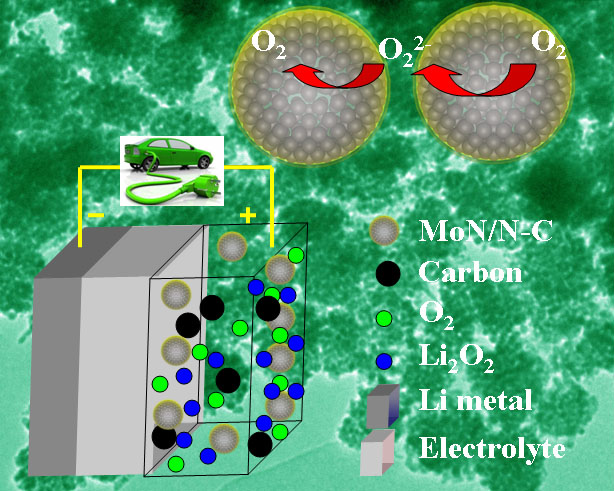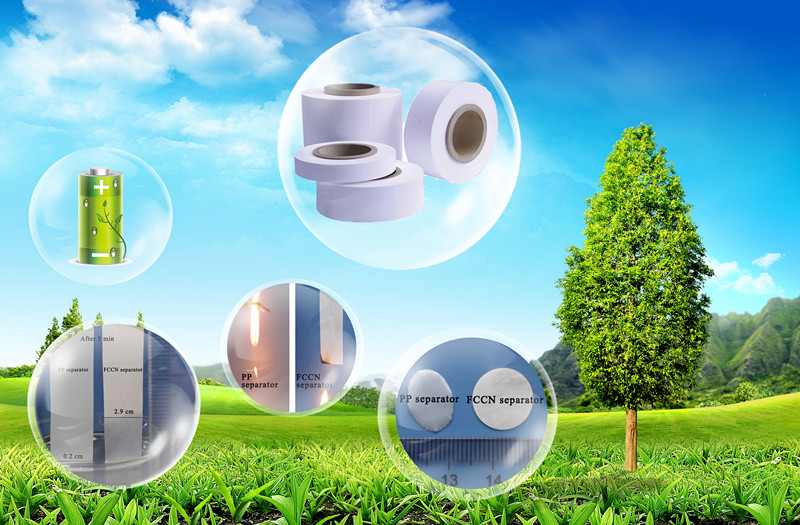Professor CUI Guanglei and his Biomimetics for Energy Storage Group from Qingdao Institute of Bioenergy and Bioprocess Technology (QIBEBT), Chinese Academy of Sciences (CAS), have made series functional materials for electrochemical energy storage.
Separators play a crucial role in the future development of high-performance power lithium batteries. However, commercial polyolefin-based separators may pose potential threaten to power lithium batteries owing to their poor dimensionally thermal stability and inferior electrolyte wettability. Thus it is a compelling challenge to exploit advanced separators for power lithium batteries with low cost, high mechanical strength, superior thermal resistance and excellent flame retardancy. Herein, Dr. ZHANG Jianjun and Dr. KONG Qingshan have fabricated sustainable, heat-resistant and flame-retardant cellulose-based composite nonwoven via papermaking method. As compared to polyolefin-based separator, such flame-retardant cellulose-based composite separator possessed good flame retardancy, superior heat tolerance and proper mechanical strength. Hence, this high performance cellulose-based separator greatly enhanced the safety performance and service life of the battery. These findings have appealed in both domestic and international journals such as Scientific Reports (2013 DOI: 10.1038/srep03935), RSC Adv. (2013 DOI: 10.1039/C3RA45879B) and ACS Sustainable Chem. Eng. (2013 DOI: 10.1021/ssc400370h).
 |
 |
|
The schematic of transition metal nitrides based Li-O2batteries(Left) and highperformance and flame-retardant cellulose composite separator (right). (Image by Prof. CUI's group) |
Perovskite solar cell is a very promising member in the photovoltaic devices. Due to its low cost and high conversion efficiency, the perovskite solar cell has been picked as an outstanding scientific achievement as the breakthrough of 2013. The traditional perovskite solar cells are based on the methylammonium lead iodide (CH3NH3PbI3). Dr. PANG Shuping used formamidinium to replace methylammonium to form a new perovskite NH2CH=NH2PbI3 with a narrowed bandgap of 1.43 eV. This new perovskite has improved light absorption property and higher thermal stability. This result has been published in Chemistry of Materials (10.1021/cm404006p)
Silicon and Germanium are considered as important alternative anodes for next generation lithium ion battery, due to their large theoretical specific capacity which greatly exceed that of graphite 3-10 times. However, limited by the huge volume changes during charge and discharge cycles, Silicon and Germanium always exhibit a poor cycling stability. Dr. ZHANG Chuanjian explored novel methods for materials fabrication which loaded nano-sized Silicon and Germanium materials into elastic skeleton to buffer their volume expansion. The composite electrodes shows enhanced long-term cyclability and corresponding results have been published on RSC Adv. (2013, 3, 1336-1340) and ACS Appl. Mater. Interfaces (2013, 5, 12340-12345).
Li-O2 batteries, which has a theoretical energy density comparable with that of gasoline, has been considered as one of the most promising energy storage devices for electric vehicles. To further improve the cycle performance of Li-O2 cell, Dr. ZHANG Lixue and Dr. DONG Shanmu developed series of cathodic electrode with enhanced interfacial stability, which significantly improve the cycleablilty. These results have been published in Chem. Comm. (2013, 49, 3540-2542), ACS Appl. Mater. Interfaces (2013, 5, 3677-3682), and J. Phys. Chem. Lett. (2014, 5, 615-621).
Lithium hexafluorophosphate (LiPF6) is predominant lithium salt in liquid electrolyte system of lithium ion battery. However, LiPF6 is known to be extremely sensitive to moisture and thermally decompose at about 60 °C. To address this issue, Dr. LIU Zhihong synthesized a novel environment friendly polymeric lithium tartaric acid borate with enhanced heat resistance. It was manifested that LiFePO4/graphite cell based on this lithium salt exhibited excellent electrochemical stability at an operating temperature of 80 °C (Electrochimica Acta, 2013, 92, 132-138). Furthermore, electrolyte with this lithium salt has proved to greatly enhance the cycle performance of Mn-based Li-ion batteries at high temperature (Solid State Ionics, 2013, DOI:10.1016/j.ssi.2013.09.007).
With these progress achieved by the research group, Qingdao government and QIBEBT are going to found the Qingdao Institute of Energy Storage Technology to accelerate the cultivation of high-tech enterprises in the areas of new materials and energy storage.
Contact:
Professor CUI Guanglei
Email: cuigl (AT) qibebt.ac.cn